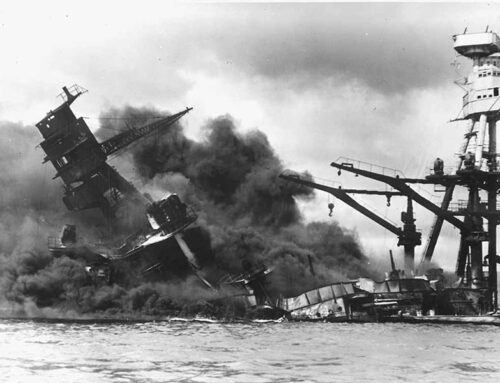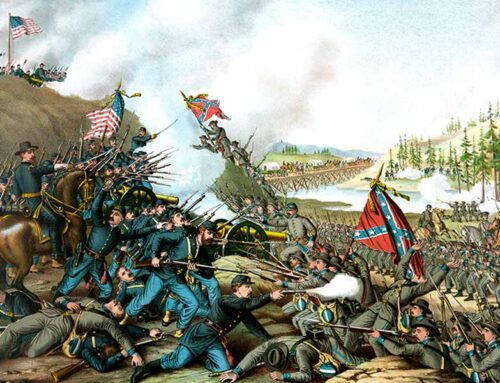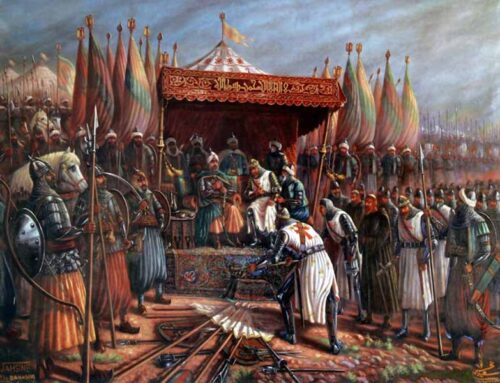“They that go down to the sea in ships, that do business in great waters; these see the works of the LORD, and his wonders in the deep. For He commands, and raises the stormy wind, which lifts up the waves.”
—Psalm 107:23-30
Captain Christopher Newport Founds
Jamestown, Virginia Colony, May 24, 1607
![]() n May 24, 1607, Captain Christopher Newport sailed his ship the Susan Constant and her companion vessels, the Godspeed and the Discovery up the river named for the English sovereign, King James, and put in to shore on an island. He called the fledgling colony Jamestown. Previous attempts of English colonization in the New World had failed or just disappeared; this one would survive, but barely. The English sailors and colonists built a stockade and mounted cannons facing the river, in case the Spanish sent a fleet from the Caribbean to exterminate them. The cannons pointed in the wrong direction, facing the wrong enemies.
n May 24, 1607, Captain Christopher Newport sailed his ship the Susan Constant and her companion vessels, the Godspeed and the Discovery up the river named for the English sovereign, King James, and put in to shore on an island. He called the fledgling colony Jamestown. Previous attempts of English colonization in the New World had failed or just disappeared; this one would survive, but barely. The English sailors and colonists built a stockade and mounted cannons facing the river, in case the Spanish sent a fleet from the Caribbean to exterminate them. The cannons pointed in the wrong direction, facing the wrong enemies.

Reenactors at the recreated Jamestown Settlement fire a cannon during a demonstration
Spanish explorers and conquistadors delivered to the monarchs of their recently unified country, in the 16th Century, a global empire, unmatched by any of their European rivals. Their colonies in the “New World” provided billions in gold, silver, gems, and raw materials that enabled Spain to sustain the only professional army on the continent and militarily rebuff their enemies: France, England, the “Holy Roman Empire,” and Portugal. Those rivals considered how they could compete for the endless riches, the millions of newly conquered peoples, and the unbounded prestige that came with their successful conquests.

Reenactors demonstrate clothing, weapons and tactics of the Jamestown Settlement era
England, under Queen Elizabeth I, had satisfied themselves with poaching the treasure ships of the Spanish Black Fleet and similarly laden vessels plying the “Spanish Main.” An imaginative and devout English clergyman named Richard Hakluyt believed that that strategy was short-sighted and inadequate. He hoped to provide England and his fellow English-speaking Reformation Protestants detailed blueprints for colonial advancement by summarizing the important and useful data of foreign empire acquisition. By interviewing explorers from many countries, reading their books and reports, as well as cosmologies that illustrated the strange and interesting cultures found in worlds previously unknown to the Europeans, Hakluyt hoped to build a case for the advance of England’s culture and commercial prosperity around the world. He articulated strategies that might enable England to evangelize the pagan tribes of North America, establish profitable enterprises, and beat Spain at their own game.

The first page of Richard Hakluyt’s work bearing the title of The Principal Navigations, Voiages, Traffiques and Discoueries of the English Nation, Made by Sea or Overland… at Any Time Within the Compasse of these 1500 [1600] Yeeres, &c

Portrait of Queen Elizabeth I of England (1533-1603) commemorating the defeat of the Spanish Armada, depicted in the background. Elizabeth’s hand rests on the globe, symbolising her international power. One of three known versions of the “Armada Portrait”.
The Queen, a voracious reader and brilliant political operator in her own right, was eventually convinced of the importance of English settlement, at least partly through the arguments of Richard Hakluyt filtered through the entreaties of her advisors. Attempts during her reign failed, notably those of her court favorite, Sir Walter Raleigh, but the vision prevailed past her death to her successor, James I.

Sir Walter Raleigh (1552-1618) was an English statesman, soldier, writer, explorer and court favorite of Queen Elizabeth I

James the VI of Scotland and I of England and Ireland (1566-1625) succeeded Elizabeth I to the throne
Wealthy Puritan merchants and noblemen formed the Virginia Company, a joint-stock investment consortium designed to subsidize the establishment of plantations in Virginia, a land named after Queen Elizabeth. The bounty of the New World would enrich the investors and adventurers and providentially establish English hegemony among the inhabitants of the wild lands of the North American continent even as they became Christians themselves.
The Company chose Captain Christopher Newport to lead the enterprise across the ocean and provide leadership, along with a handful of others, for the construction of a successful colony. Born in 1561, Newport had spent his life on the seas of the world, initially as a commercial trader and master-seaman. When an undeclared war broke out between England and Spain in 1585—which lasted off and on for abut twenty years—Newport captained a series of privateering ships, financed by the London merchant John Watts, raiding Spanish ports in the Caribbean and capturing their trading and treasure ships. In one fight with an enemy galleon, Newport lost an arm. He assisted in the capture of the Madre de Deus (“Mother of God”) in 1596, a Portuguese ship which proved to be the mother of all prizes of the century, laden with five hundred tons of silks, spices and gems. He sailed with the most famous of English privateers, Sir Francis Drake, and, by the end of his career, had raided the Spanish Main more times than Drake.

Captain Christopher Newport (1561–1617)

The James River, so named in honor of King James
The Virginia Company knew they had the right man to lead the adventure of a colonial start-up on the newly christened James River. Landing a little over a hundred colonists, Newport saw to the building of the fort that would protect the colony, and a week later, left with two of the ships to return to England for resupply. In the winter of 1607-08, more than half the colonists died from disease and starvation. Their relations with the local natives did not go well. The colonists had settled next to the most powerful and militant tribes of the region, and attempted to build a colony without bringing farmers to grow food, but carrying plenty of gentlemen in kid gloves to pick up the gold they hoped to find on the beaches and natives to obediently serve their needs. One of the council members, John Smith—a short, red-headed soldier of fortune—enabled the colony to hang on by a thread, forcing everyone to work, negotiating with the natives, and exploring the region with an eye for subsistence.

Captain John Smith (1580-1631)

A recreation of the fort at Jamestown Settlement
Seemingly at their last extremity, the survivors welcomed Christopher Newport, who arrived with supplies in January, 1608 and 120 more male colonists. He left for England immediately and returned in September with more supplies and colonists, including the first two women. Smith had continued his successful diplomacy with the local paramount chief, known by the colonists as Chief Powhatan, but relations between the two diverse cultures still made the success of the venture highly questionable.

A mass grave at Jamestown Settlement, discovered by archeologists
Newport’s third supply foundered on an island in the Bermudas but eventually arrived at Jamestown ten months later, where he found that 80% of the English colonists had died. After Captain Newport’s fifth mission to Jamestown, he made three voyages to India and died in Java in 1617 of unknown causes. Without Captain Christopher Newport, the colonizing venture of England’s first permanent colony in the New World likely would not have survived. Many interesting providential events accompanied his life, that of a pirate according to the Spanish. Towns, a city, and a university are named after him in the United States, and a powerful statue of the Captain is installed on the campus that bears his name. They are reminders of his importance to our history. The statue has two arms, for the artist believes our heroes should be shown as complete men. What do you think?

A replica of the Godspeed in New York, one of Newport’s ships on his first voyage to the New World
Image Credits: 1 Cannon demonstration (wikipedia.org) 2 Reenactors (wikipedia.org) 3 Hakluyt’s book (wikipedia.org) 4 Queen Elizabeth I (wikipedia.org) 5 Sir Walter Raleigh (wikipedia.org) 6 James I (wikipedia.org) 7 Captain Christopher Newport (wikipedia.org) 8 James River (wikipedia.org) 9 Captain John Smith (wikipedia.org) 10 Jamestown Fort (wikipedia.org) 11 Mass grave (wikipedia.org) 12 Godspeed replica (wikipedia.org)






